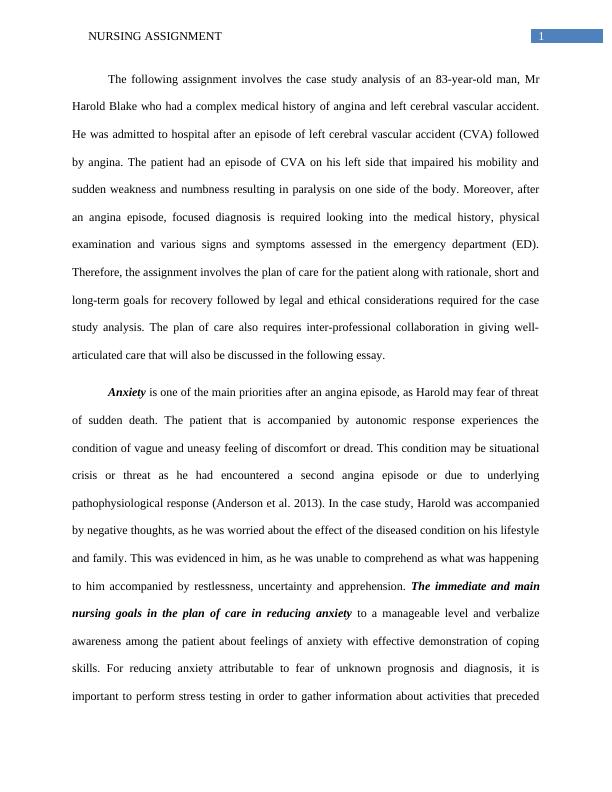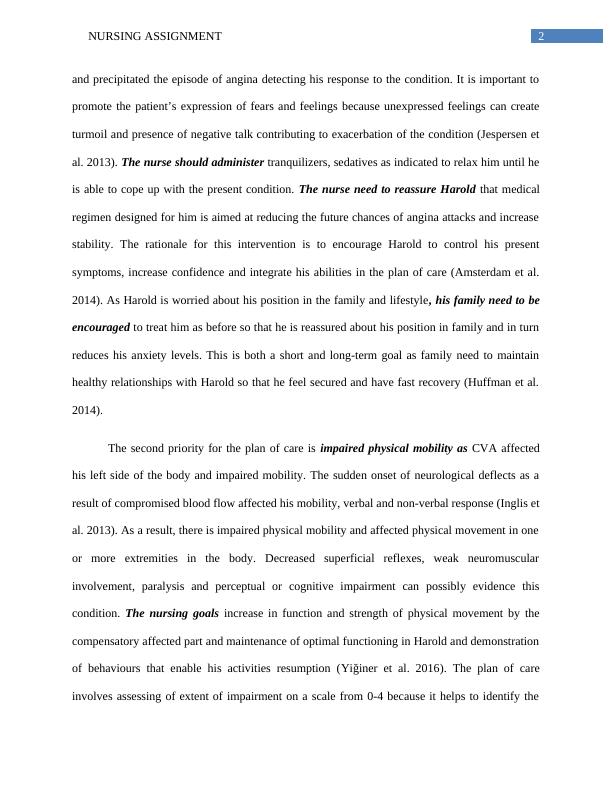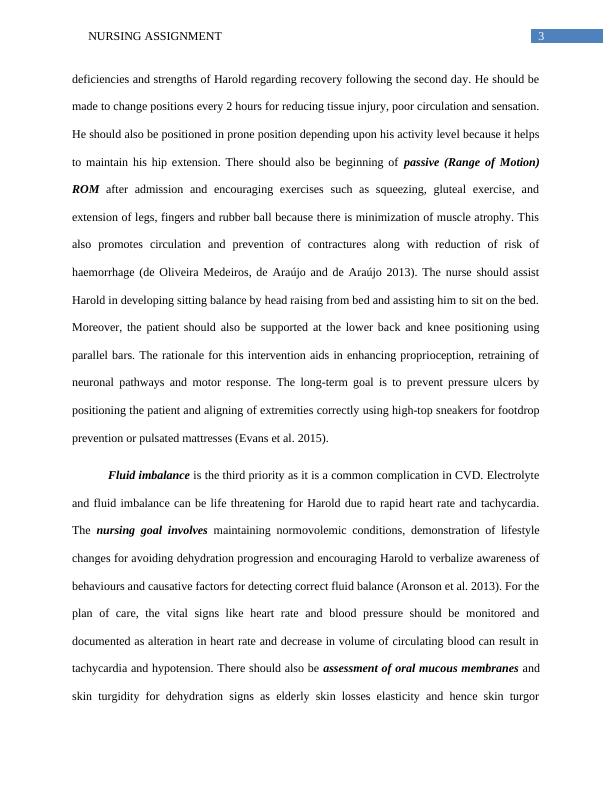Case Study Analysis of an 83-Year-Old Man with Angina and Cerebral Vascular Accident
Added on 2023-06-15
14 Pages3857 Words480 Views
Running head: NURSING ASSIGNMENT
Nursing assignment
Name of the Student
Name of the University
Author note
Nursing assignment
Name of the Student
Name of the University
Author note

1NURSING ASSIGNMENT
The following assignment involves the case study analysis of an 83-year-old man, Mr
Harold Blake who had a complex medical history of angina and left cerebral vascular accident.
He was admitted to hospital after an episode of left cerebral vascular accident (CVA) followed
by angina. The patient had an episode of CVA on his left side that impaired his mobility and
sudden weakness and numbness resulting in paralysis on one side of the body. Moreover, after
an angina episode, focused diagnosis is required looking into the medical history, physical
examination and various signs and symptoms assessed in the emergency department (ED).
Therefore, the assignment involves the plan of care for the patient along with rationale, short and
long-term goals for recovery followed by legal and ethical considerations required for the case
study analysis. The plan of care also requires inter-professional collaboration in giving well-
articulated care that will also be discussed in the following essay.
Anxiety is one of the main priorities after an angina episode, as Harold may fear of threat
of sudden death. The patient that is accompanied by autonomic response experiences the
condition of vague and uneasy feeling of discomfort or dread. This condition may be situational
crisis or threat as he had encountered a second angina episode or due to underlying
pathophysiological response (Anderson et al. 2013). In the case study, Harold was accompanied
by negative thoughts, as he was worried about the effect of the diseased condition on his lifestyle
and family. This was evidenced in him, as he was unable to comprehend as what was happening
to him accompanied by restlessness, uncertainty and apprehension. The immediate and main
nursing goals in the plan of care in reducing anxiety to a manageable level and verbalize
awareness among the patient about feelings of anxiety with effective demonstration of coping
skills. For reducing anxiety attributable to fear of unknown prognosis and diagnosis, it is
important to perform stress testing in order to gather information about activities that preceded
The following assignment involves the case study analysis of an 83-year-old man, Mr
Harold Blake who had a complex medical history of angina and left cerebral vascular accident.
He was admitted to hospital after an episode of left cerebral vascular accident (CVA) followed
by angina. The patient had an episode of CVA on his left side that impaired his mobility and
sudden weakness and numbness resulting in paralysis on one side of the body. Moreover, after
an angina episode, focused diagnosis is required looking into the medical history, physical
examination and various signs and symptoms assessed in the emergency department (ED).
Therefore, the assignment involves the plan of care for the patient along with rationale, short and
long-term goals for recovery followed by legal and ethical considerations required for the case
study analysis. The plan of care also requires inter-professional collaboration in giving well-
articulated care that will also be discussed in the following essay.
Anxiety is one of the main priorities after an angina episode, as Harold may fear of threat
of sudden death. The patient that is accompanied by autonomic response experiences the
condition of vague and uneasy feeling of discomfort or dread. This condition may be situational
crisis or threat as he had encountered a second angina episode or due to underlying
pathophysiological response (Anderson et al. 2013). In the case study, Harold was accompanied
by negative thoughts, as he was worried about the effect of the diseased condition on his lifestyle
and family. This was evidenced in him, as he was unable to comprehend as what was happening
to him accompanied by restlessness, uncertainty and apprehension. The immediate and main
nursing goals in the plan of care in reducing anxiety to a manageable level and verbalize
awareness among the patient about feelings of anxiety with effective demonstration of coping
skills. For reducing anxiety attributable to fear of unknown prognosis and diagnosis, it is
important to perform stress testing in order to gather information about activities that preceded

2NURSING ASSIGNMENT
and precipitated the episode of angina detecting his response to the condition. It is important to
promote the patient’s expression of fears and feelings because unexpressed feelings can create
turmoil and presence of negative talk contributing to exacerbation of the condition (Jespersen et
al. 2013). The nurse should administer tranquilizers, sedatives as indicated to relax him until he
is able to cope up with the present condition. The nurse need to reassure Harold that medical
regimen designed for him is aimed at reducing the future chances of angina attacks and increase
stability. The rationale for this intervention is to encourage Harold to control his present
symptoms, increase confidence and integrate his abilities in the plan of care (Amsterdam et al.
2014). As Harold is worried about his position in the family and lifestyle, his family need to be
encouraged to treat him as before so that he is reassured about his position in family and in turn
reduces his anxiety levels. This is both a short and long-term goal as family need to maintain
healthy relationships with Harold so that he feel secured and have fast recovery (Huffman et al.
2014).
The second priority for the plan of care is impaired physical mobility as CVA affected
his left side of the body and impaired mobility. The sudden onset of neurological deflects as a
result of compromised blood flow affected his mobility, verbal and non-verbal response (Inglis et
al. 2013). As a result, there is impaired physical mobility and affected physical movement in one
or more extremities in the body. Decreased superficial reflexes, weak neuromuscular
involvement, paralysis and perceptual or cognitive impairment can possibly evidence this
condition. The nursing goals increase in function and strength of physical movement by the
compensatory affected part and maintenance of optimal functioning in Harold and demonstration
of behaviours that enable his activities resumption (Yiğiner et al. 2016). The plan of care
involves assessing of extent of impairment on a scale from 0-4 because it helps to identify the
and precipitated the episode of angina detecting his response to the condition. It is important to
promote the patient’s expression of fears and feelings because unexpressed feelings can create
turmoil and presence of negative talk contributing to exacerbation of the condition (Jespersen et
al. 2013). The nurse should administer tranquilizers, sedatives as indicated to relax him until he
is able to cope up with the present condition. The nurse need to reassure Harold that medical
regimen designed for him is aimed at reducing the future chances of angina attacks and increase
stability. The rationale for this intervention is to encourage Harold to control his present
symptoms, increase confidence and integrate his abilities in the plan of care (Amsterdam et al.
2014). As Harold is worried about his position in the family and lifestyle, his family need to be
encouraged to treat him as before so that he is reassured about his position in family and in turn
reduces his anxiety levels. This is both a short and long-term goal as family need to maintain
healthy relationships with Harold so that he feel secured and have fast recovery (Huffman et al.
2014).
The second priority for the plan of care is impaired physical mobility as CVA affected
his left side of the body and impaired mobility. The sudden onset of neurological deflects as a
result of compromised blood flow affected his mobility, verbal and non-verbal response (Inglis et
al. 2013). As a result, there is impaired physical mobility and affected physical movement in one
or more extremities in the body. Decreased superficial reflexes, weak neuromuscular
involvement, paralysis and perceptual or cognitive impairment can possibly evidence this
condition. The nursing goals increase in function and strength of physical movement by the
compensatory affected part and maintenance of optimal functioning in Harold and demonstration
of behaviours that enable his activities resumption (Yiğiner et al. 2016). The plan of care
involves assessing of extent of impairment on a scale from 0-4 because it helps to identify the

3NURSING ASSIGNMENT
deficiencies and strengths of Harold regarding recovery following the second day. He should be
made to change positions every 2 hours for reducing tissue injury, poor circulation and sensation.
He should also be positioned in prone position depending upon his activity level because it helps
to maintain his hip extension. There should also be beginning of passive (Range of Motion)
ROM after admission and encouraging exercises such as squeezing, gluteal exercise, and
extension of legs, fingers and rubber ball because there is minimization of muscle atrophy. This
also promotes circulation and prevention of contractures along with reduction of risk of
haemorrhage (de Oliveira Medeiros, de Araújo and de Araújo 2013). The nurse should assist
Harold in developing sitting balance by head raising from bed and assisting him to sit on the bed.
Moreover, the patient should also be supported at the lower back and knee positioning using
parallel bars. The rationale for this intervention aids in enhancing proprioception, retraining of
neuronal pathways and motor response. The long-term goal is to prevent pressure ulcers by
positioning the patient and aligning of extremities correctly using high-top sneakers for footdrop
prevention or pulsated mattresses (Evans et al. 2015).
Fluid imbalance is the third priority as it is a common complication in CVD. Electrolyte
and fluid imbalance can be life threatening for Harold due to rapid heart rate and tachycardia.
The nursing goal involves maintaining normovolemic conditions, demonstration of lifestyle
changes for avoiding dehydration progression and encouraging Harold to verbalize awareness of
behaviours and causative factors for detecting correct fluid balance (Aronson et al. 2013). For the
plan of care, the vital signs like heart rate and blood pressure should be monitored and
documented as alteration in heart rate and decrease in volume of circulating blood can result in
tachycardia and hypotension. There should also be assessment of oral mucous membranes and
skin turgidity for dehydration signs as elderly skin losses elasticity and hence skin turgor
deficiencies and strengths of Harold regarding recovery following the second day. He should be
made to change positions every 2 hours for reducing tissue injury, poor circulation and sensation.
He should also be positioned in prone position depending upon his activity level because it helps
to maintain his hip extension. There should also be beginning of passive (Range of Motion)
ROM after admission and encouraging exercises such as squeezing, gluteal exercise, and
extension of legs, fingers and rubber ball because there is minimization of muscle atrophy. This
also promotes circulation and prevention of contractures along with reduction of risk of
haemorrhage (de Oliveira Medeiros, de Araújo and de Araújo 2013). The nurse should assist
Harold in developing sitting balance by head raising from bed and assisting him to sit on the bed.
Moreover, the patient should also be supported at the lower back and knee positioning using
parallel bars. The rationale for this intervention aids in enhancing proprioception, retraining of
neuronal pathways and motor response. The long-term goal is to prevent pressure ulcers by
positioning the patient and aligning of extremities correctly using high-top sneakers for footdrop
prevention or pulsated mattresses (Evans et al. 2015).
Fluid imbalance is the third priority as it is a common complication in CVD. Electrolyte
and fluid imbalance can be life threatening for Harold due to rapid heart rate and tachycardia.
The nursing goal involves maintaining normovolemic conditions, demonstration of lifestyle
changes for avoiding dehydration progression and encouraging Harold to verbalize awareness of
behaviours and causative factors for detecting correct fluid balance (Aronson et al. 2013). For the
plan of care, the vital signs like heart rate and blood pressure should be monitored and
documented as alteration in heart rate and decrease in volume of circulating blood can result in
tachycardia and hypotension. There should also be assessment of oral mucous membranes and
skin turgidity for dehydration signs as elderly skin losses elasticity and hence skin turgor

End of preview
Want to access all the pages? Upload your documents or become a member.
Related Documents
Nursing Diagnoses for Mr. Harold: Impaired Mobility and Impaired Skin Integritylg...
|12
|2989
|34
Critical Nursing Care: Plan of Care for Patients with Cerebral Vascular Attacklg...
|11
|2920
|132
Nursing Case Study Analysis of Harold Blakelg...
|11
|3251
|83
Development of a Person Centred Care Planlg...
|11
|2327
|91
Nursing assignment sample PDFlg...
|13
|4463
|83
Harold Blake Case Studylg...
|12
|3105
|81